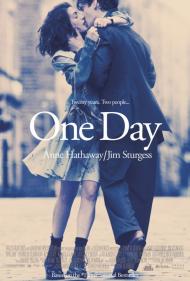Movie Review
Same Time, Next Year
They couldn't have celebrated happier anniversaries if they were married to each other.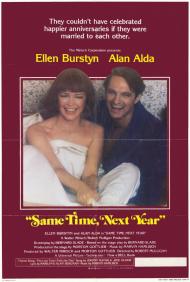
US Release Date: 11-22-1978
Directed by: Robert Mulligan
Starring▸▾
- Ellen Burstyn, as
- Doris
- Alan Alda, as
- George Peters
- Ivan Bonar, as
- Chalmers
- Bernie Kuby, as
- Waiter
- Cosmo Sardo, as
- Second Waiter
- David Northcutt, as
- Pilot #1
- William Cantrell as
- Pilot #2
![3 star[s] out of 4](http://www.threemoviebuffs.com/static/images/global/featured_gold_stars.png)
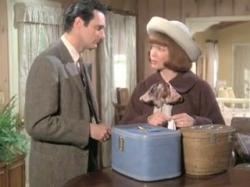
Alan Alda and Ellen Burstyn in Same Time, Next Year.
I must have been around 12 when I saw this movie for the first time. It was one of the ones they seemed to show repeatedly on HBO in the early 1980s. It might seem like an odd movie for a 12 year old to latch onto, but then we were odd kids in the Nash household. The fact that it starred Alan Alda, who, thanks to his role of Hawkeye on M*A*S*H, was one of my early idols, probably explains part of the appeal it held for me at the time, but certainly can't explain all of it.
Watching it now, for the first time in decades, I still enjoyed it, but understandably had a different perspective on it. As a child I saw the romance of the story, but completely overlooked the infidelity aspects of the plot, while today I had a much harder time getting past that plot point. Also at one point in the story, Alda remarks to Burstyn that they have been referring to Chalmers as Old Chalmers for as long as they can remember even though when they first did, he was younger than their characters were when Alda makes the remark. I felt a little like that watching the story. At 12, Alda and Burstyn were mature grown-ups far beyond my young age, but now, I am much older than the characters are supposed to be when the story begins.
The script is by Bernard Slade and is based on his Tony Award winning play. Although there is some attempt to give the movie a broader, more open feel, by including some scenes outside of the hotel room, the film still feels very much like a play. There are a couple of minor characters as extras, but only the two starring roles. Despite the inclusion of a scene in a car, a restaurant, an airport and a couple of scenes outdoors, 90% of it takes place in just one room. Personally, I don't think they needed to even bother with the few scenes outside of the room. This is a movie that's all about the dialogue and character interaction. You don't need anything else. In any case, the black and white photos of events taking place in the world that are shown in-between scenes gives the impression that there's a world outside this room, it's just not one that we need to concern ourselves with except in the way it gives a context to the couple's changing dress styles, slang and social attitudes.
Possibly another aspect of the film that appealed to my younger self is the unique structure of the story. Burstyn and Alda play a couple who meet at a restaurant in 1951. Both are married to other people, but they begin an affair anyway. After we see their awkward first night and morning after together, the story jumps forward five years where we learn that the couple has continued to meet at the same hotel on the same day each year. The film continues in this fashion, checking in on the couple roughly once every five years on the same day, covering the years from 1951 to 1977.
Although there's some drama built-in to the story, the best moments are the comedic ones. Alda is neurotic and nervous when they first meet while Burstyn is naive, but pragmatic. Their characters evolve over time, often in service of the jokes, even if not always realistically. This is most obvious in the 1960s and 1970s. Burstyn's character becomes a hippy cliche in the 1960s, despite being a typical housewife in the 50s and going on to being a businesswoman in the 1970s, while Alda goes from being stodgy and grief stricken (in the film's most successful dramatic moment) over the death of his son in Vietnam, to being a stereotypical 1970s swinger just five years later. These swings in their character aren't entirely realistic, but they are often amusing.
I still enjoyed this movie this time around, but the nagging thought that these two characters were cheating on their spouses once a year did bother me this time in a way that it never did when I was 12. As a comedy, it's easier to forgive them, but as a drama I kept thinking, especially whenever they mention their spouses, that they were lying and cheating on them.
Burstyn and Alda are both terrific in their parts. Burstyn won the Tony Award for this part on Broadway and was nominated for an Oscar for the film version. Both of them do seem a little too old for the early scenes, especially Burstyn, but as their characters age they age well with them. The makeup team does a good job aging them subtly rather than overdoing the prosthetics.
As a comedy and a nostalgic visit to a movie I loved as a child, this movie succeeds. It's slightly less successful as a drama, but I still enjoyed it. Perhaps not a movie worth revisiting once a year, but I could see myself watching it again.
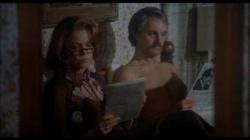
Ellen Burstyn and Alan Alda in Same Time, Next Year.
Like Scott, I have fond memories of watching this movie as a kid. The passage of time as romantically depicted in the movie really appealed to me. Watching it now I wasn't particularly bothered by the fact that they are both married to other people (not that I am condoning infidelity mind you), it's just that the story wouldn't work otherwise. It's the only believable explanation for why these two people don't get together on a permanent basis. Yes it's a flaw in their personalities but the script addresses the guilt involved and in the case of George, we later find out that his wife had long known of the ongoing affair.
I agree that their changing personality traits aren't always realistic but they are fun. It allows the script a chance to poke fun at the changing styles and attitudes of the previous quarter century. From the conservative early fifties through the counterculture sixties and into the swinging seventies, Same Time, Next Year covers a lot of ground in a concise manner.
Both Ellen Burstyn and Alan Alda are very good in this movie. I like how George and Doris always take a while to warm up to each other at the beginning of each tryst. The script is clever. One of the best details is the fact that they each tell the other, one positive story about their spouse and one negative story about their spouse, per visit. This enables us to feel as if we know Helen and Harry (the spouses) as we follow the ups and downs of George's and Doris's marriages.
It's funny how certain lines from movies stick with you. I have always vividly recalled the scene where they are about to make love when the phone rings. George reluctantly answers it only to discover it is his youngest daughter calling. He is racked with guilt and the line I always remember is when he tells Doris, “I just spoke to my daughter in a voice still hoarse with passion.”
Much of the dialogue is memorable. In 1966 when George starts complaining about the changing times Doris tells him, “You know that's a sign of age, don't you?” George: “What?” Doris: “When you start worrying about the declining morality of the young.” How true. My favorite exchange between them occurs during the last night depicted of their affair. They are now middle-aged and looking back on the 26 years they have been meeting. George says, “I can't remember the name of your favorite perfume; I've racked my brain and I can't remember it.” Comes the ironic reply, “That's funny, it's My Sin.” Now that's good writing.
As it did for Scott, Same Time, Next Year also provided a nostalgic trip down memory lane for me. It took me back more than 30 years to our living room at 210 Dixie and that cumbersome color television we owned. I can picture the entire family sitting around watching this movie. Scott and I are most likely sitting on the floor completely caught up in Ellen Burstyn's and Alan Alda's created illusion of a decades spanning love affair.
![3 star[s] out of 4](http://www.threemoviebuffs.com/static/images/global/featured_gold_stars.png)
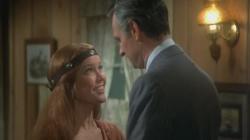
Ellen Burstyn and Alan Alda in Same Time, Next Year
The initial meeting between George and Doris is glossed over as just a physical attraction. The morning after their first night together they both have weird looks on their faces. I cannot tell if George is proud or embarrassed, while Burstyn looks nervous. After a brief conversation, George says to Doris, “I think I am in love with you.” By the end of that first scene we understand that they are in love and that they each have a need for each other.
Agreeing with my brothers, the character development is not always convincing. Most people grow over time but these two seem to become all new people every five years. George changing jobs from a CPA to a lounge piano player can be dismissed as a mid-life crisis but is not very explored.
Doris changes the most. She starts as a naïve, uneducated Irish catholic with three children. Five years later she has another baby. Five years later she is now a college hippy going to protests and adamantly supporting liberal politicians. A natural path of growth would have been for her to become more mature, not transform from 1950s stay at home mother to 1960s radical. How could this thirty something mother of four not only find time to go to college but attend political rallies where she becomes influenced by others, ten years her junior. Five years later she is a capitalist running a million dollar business. Five years later she is back to being a stay at home wife.
This is not to say that the script is not without merit. Bernard Slade wrote dialogue that demands you pay attention. Not only do the spouses become characters but so does George’s son Michael. Doris and George change over time in how they speak. At one point, George talks as if he is a therapist. Both characters become more intellectual as time goes on. In 1977, they sound nothing like they do in 1951.
I am with Scott that the infidelity is a huge black mark on both of them. George speaks of guilt while Doris clearly only married her husband because she got pregnant at a young age. We get the idea that each of their spouses are more like friends while each other is the love of their life. Either way, both Doris and George are living double lives and lies. There is nothing respectable about that.
I have a hypothetical question. Would George and Doris have made it as a married couple that saw each other every day? They argue as much as they make love on their yearly weekends. Is their relationship successful because they only see each other annually or would they have had a long blissful marriage?
Photos © Copyright Universal Pictures (1978)

